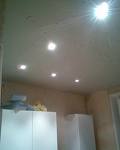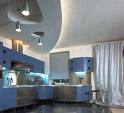Modern requirements for the electrical supply of the kitchen
The kitchen in a modern apartment is a very active user of electricity.
A modern kitchen cannot be presented without a refrigerator, electric stove, coffee maker, kettle, juicer and even a small TV.
And if you add a washing machine and a dishwasher to them? As you can see, all this comfortable life consists of consumers of electricity. All household appliances are energy intensive and make the kitchen a place worthy of great attention from a safety point of view. Therefore, first of all, you need to approach the electrical wiring responsibly, since it is in the kitchen that it is one of the most vulnerable places in the general electrical network of the apartment.
So that you don't have serious problems with power supply, even before the start of repair and construction work in the kitchen, you should carefully consider electrical engineering: calculate the power that will be consumed by all electrical appliances in the house, taking into account that there may be more of them in the future.Of course, not all devices will work at the same time, but nevertheless the calculation must be done for everything. In addition, it is necessary to establish the power supply potential of the house itself.
All wires used in kitchen wiring should be double-insulated and, if possible, placed in moisture-resistant plastic pipes, which makes it more reliable.
 For the kitchen, it is advisable to make a separate electrical wiring, since the power of modern household appliances is large, and a separate machine for turning off the power supply in the kitchen is simply necessary. In addition, for wiring you should use a more powerful electric drive with a cross section of 2.5 or 4 mm2, and for an electric stove - with a cross section of 4 mm2 or, if the drive is aluminum, with a cross section of 6 mm2. Of course, it is better to use copper cables with double insulation of the following basic standards:
For the kitchen, it is advisable to make a separate electrical wiring, since the power of modern household appliances is large, and a separate machine for turning off the power supply in the kitchen is simply necessary. In addition, for wiring you should use a more powerful electric drive with a cross section of 2.5 or 4 mm2, and for an electric stove - with a cross section of 4 mm2 or, if the drive is aluminum, with a cross section of 6 mm2. Of course, it is better to use copper cables with double insulation of the following basic standards:
- 3×1.5 or 3×2.5 mm;
- 3×4 or 3×6 mm (for an electric stove).
In these designations, the first digit is the number of drives, and the second is the cross section of the cores.
Electrical wiring is usually hidden in walls, and walls in residential buildings can get hot and wet. This can happen for various reasons (spikes in temperature, change in humidity, etc.), which is why double insulation is necessary. In addition, each of the large consumers of electricity in the kitchen (refrigerator, stove, dishwasher or washing machine) must necessarily have a personal contact, as well as a differential machine or residual current device (RCD) on the common supply board of the apartment (in accordance with all installation rules).RCD eliminates current leakage and protects against damage. Often in new apartments, this device is installed together with an automatic shutdown.
 According to modern requirements, electrical wiring must be divided into independent branches serving different user groups, for example, a group of lighting sockets, a group of power devices (washing machine, electric stove). Each group should be controlled by a separate circuit breaker and ideally a separate RCD. To do this, independent (starting from the switchboard) conductors for the "phase" (one or three, depending on what power is needed, three- or single-phase), for "neutral" and for ground must be laid to each group.
According to modern requirements, electrical wiring must be divided into independent branches serving different user groups, for example, a group of lighting sockets, a group of power devices (washing machine, electric stove). Each group should be controlled by a separate circuit breaker and ideally a separate RCD. To do this, independent (starting from the switchboard) conductors for the "phase" (one or three, depending on what power is needed, three- or single-phase), for "neutral" and for ground must be laid to each group.
Unfortunately, in most apartments there is no separate grounding wire, and therefore it is impossible to properly connect household appliances equipped with plugs with grounding contacts. Even if you install a suitable outlet, you will not be able to separate the neutral and ground. In addition, if the wiring in the apartment is divided into separate groups and several circuit breakers are installed, this only ensures that separate power wires are laid. The neutral wire can be shared by different groups. In order for the RCD to control a separate group, the independence of both the supply wire and the «neutral» is required.
For small household appliances in the kitchen, it is recommended to install groups of two or three sockets, as well as to make conclusions for additional lighting near the sink and connect an air filter.
It is recommended to use double or triple sockets for small household appliances only if each socket has separate wires, and the sockets should be located so that the appliances can be easily switched on and off. They are usually placed above work surfaces at a low height.
When connecting, it is necessary to pay attention to the power of each specific element, so that during the simultaneous operation, for example, of an electric oven, microwave oven, electric meat grinder or food processor, the automatic plug does not close or «take off».
Today, mostly European sockets are installed in the kitchen, since most modern household appliances, including domestic ones, have European standard plugs.
Devices with conventional and household plugs (TVs, tape recorders) are connected via adapters or require the installation of separate sockets. True, there are combined options for contacts with conventional and European inputs.
Ceramic sockets are considered the best because they do not melt, do not burn and have the highest safety rating. In principle, contacts are selected in accordance with needs and material capabilities. The imported heat-resistant plastic sockets are of good quality.
 You can also place the sockets directly on the work surfaces of the built-in kitchen furniture. As they say, a matter of taste. However, this is due to the wiring and its insulation. In general, it is not recommended to use extension cords in kitchens, as they are poorly insulated from moisture and create too much stress on the main outlet, which is not designed to work in such conditions.The conditions in the kitchen are downright extreme (steam, humidity, temperature fluctuations, etc.).
You can also place the sockets directly on the work surfaces of the built-in kitchen furniture. As they say, a matter of taste. However, this is due to the wiring and its insulation. In general, it is not recommended to use extension cords in kitchens, as they are poorly insulated from moisture and create too much stress on the main outlet, which is not designed to work in such conditions.The conditions in the kitchen are downright extreme (steam, humidity, temperature fluctuations, etc.).
Existing (especially in old residential buildings) bushings with wires with a small cross-section often cannot provide power to modern household appliances with a voltage of 220 V. According to existing standards, if the total power of apartment energy consumers exceeds 10 kW, a three-phase ( 380 V) power supply. Where houses are equipped with gas stoves, there is no three-phase cable network. In a house where there is such a network, its operation requires competent use: the uneven load on each of the three phases, i.e. connecting to one of the phases of devices with a total power greater than the second or third phase can lead to overheating of the wires and their burning.
The better the kitchen is equipped with household appliances, the more attention should be paid to electrical wiring.
